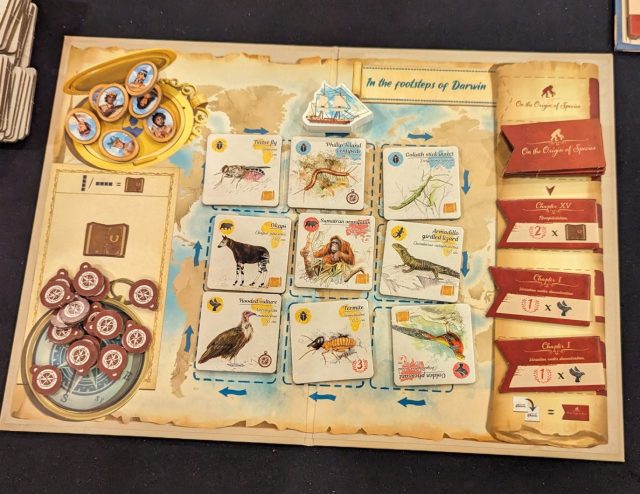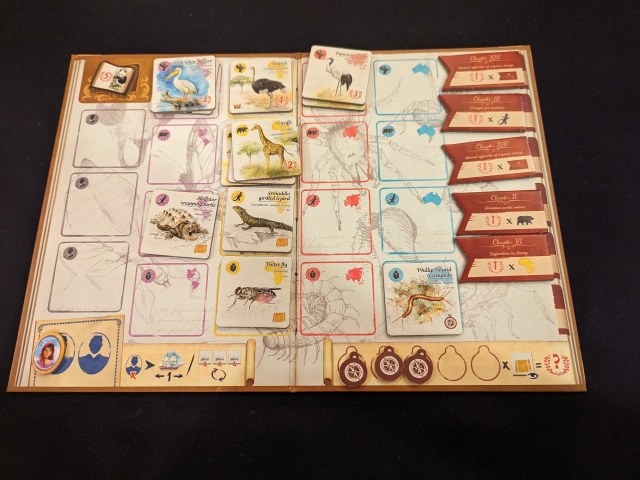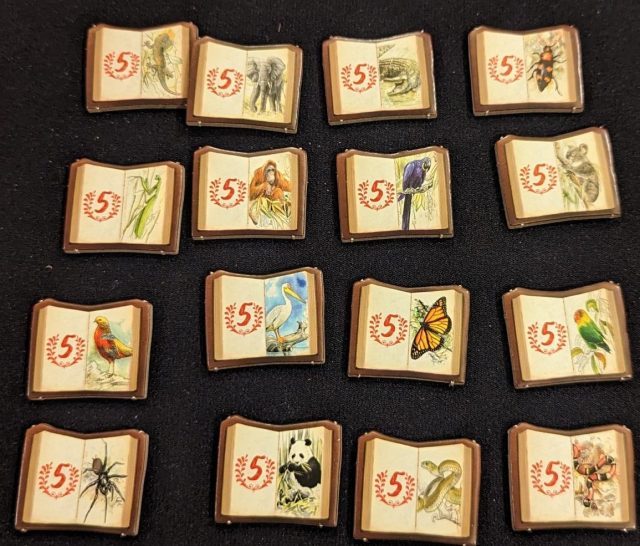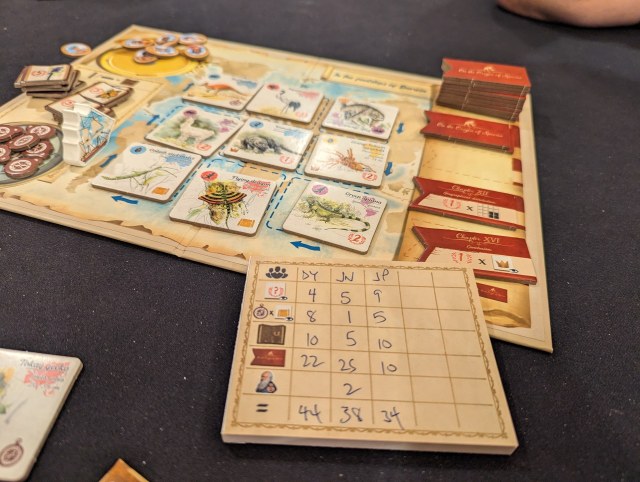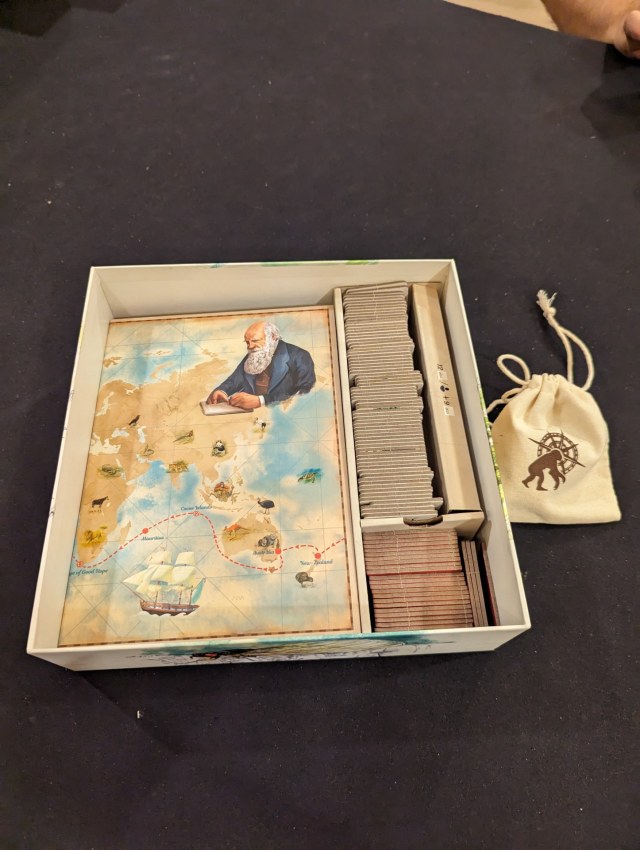In the Footsteps of Darwin
- Designers: Grégory Grard, Matthieu Verdier
- Publisher: Sorry We Are French
- Players: 2-5
- Age: 8+
- Time: 20-30 minutes
- Played with review copy provided by Hachette USA
As part of our buildup to the announcement of the Spiel des Jahres and Kennerspiel des Jahres this weekend, we are looking at the 3 nominees for each award again.
Per the publisher: Twenty years after his expedition around the world, Charles Darwin is writing On the Origins of Species. He wants to gather new information about animal life, particularly about continents he hardly explored. Who other than young naturalists, eager for discovery, could help the renowned scholar finish writing his most famous work? In In the Footsteps of Darwin, players are junior naturalists who have just arrived aboard the Beagle to help Charles Darwin finish his book On the Origin of Species. During this journey, you will study animals, carry out cartographic surveys, publish your findings, and develop theories…. Your goal is to score more points than your opponents to determine who contributed the most to On the Origin of Species.
To set up the game, the board is placed on the table, with the Voyage side face up. The supply of Animal and Character tiles is shuffled together and then 9 tiles are placed on the board. You then draw 12 tiles per player in the game and form a face down stack near the board. Each player takes a personal Journal board. Each is dealt a Theory tile which goes on the right of the Journal. Each player also puts a Guide token in the bottom left. Three Theory tiles are dealt to the main board, and all the other bits are also placed on their appropriate spots on the board. The Beagle ship is placed on the starting space on the board – it will traverse a track around the 3×3 grid of tiles.
On a turn, a player must do two things in order: Take a tile from the board in the row/column where the Beagle is, and then Voyage the Beagle.
Before taking a tile, the player can choose to use a Guide (assuming they have one available). You can either sail the Beagle one space in either direction or you can use it to discard and replace the three tiles in your current location.
Now, you must take one of the tiles that are “facing” the Beagle – that is, one of the three tiles in the row or column at the Beagle’s current location.
If you take an animal tile, you will see that the name and ecosystem is found in the upper right, the animal class in the upper left. The tile should be placed in a spot in your notebook that matches the ecosystem and class. In the lower right of the tile, you may find a discrete VP value, a survey icon which grants you a compass token, a gold chart which scores based on how many compassess you have, or a guide icon which gets you a guide token. Some of the tiles have a crown in the lower left; if you draft a tile with a crown, you immediately take the Darwin token from whoever has it currently.
If you place an animal tile into a space which already contains a tile, you are allowed to draw a Theory tile, either from the three face up on the board or facedown from the top of a draw pile. These Theories will score points at the end of the game. Note, that you can only score VPs for visible Animal tiles, so will lose any points from tiles that are covered. Also, if you have completed a row or column for the first time, you write a publication. Take a publication tile from the supply – it will score at the end of the game.
If you take a Character tile, place it on one of the three character spaces on the left of your board and then gain whatever bonus is printed on the tile.
Finally, you must move the Beagle. You move it clockwise around the track as many spaces as the distance between the ship and the tile you took (i.e. 1, 2 or 3 spaces forward). Replace the hole in the array with a new tile from the supply.
The game continues until each player has had 12 turns, and each has placed 12 tiles onto their notebook (you’ll also be clued in as the Draw stack of tiles will be exhausted). Each player now tallies their points:
- Discoveries – VPs seen on animal tiles
- Charts – multiple the number of chart icons on your visible tiles by the compasses you have
- Publications – 5VP each
- Theories – score each based on the scoring criteria on the tile
- Darwin Token – 2VP to whoever holds the token at the end of the game
The player with the most points wins. Ties broken in favor of the player with the most points from Theories
My thoughts on the game
Well, in the time it takes you to read this review, my regular group would be about halfway done with their game of In The Footsteps of Darwin; it is really a quick moving game. You’ll only get 12 turns in the game, and each turn is pretty simple. Look at your choices, if you have a Guide, consider moving the ship, then take a tile and place it. Move the ship for the next person.
But, saying that the turns are quick and easy does not mean that you don’t have to think about what you’re doing. The selection of the right tile has a lot of factors – are you trying to further one of your goal tiles? Are you trying to match the icon on the tile so that you are able to take another goal tile? Are you working towards finishing a column? Is it providing you with a chart or compass or does it score by itself?
As you can see, there are definitely a lot of reasons to take a tile, and rarely will you only have one tile that seems to help your purposes. In fact, more often than not, the decision is finding a tile that provides a combination of positive effects to your board…
Another consideration is the movement of the Beagle – as the tile that you choose will directly influence the initial choices of the next player. Though I don’t know if I’ve ever done it myself, I do know that some people will include this aspect in their decision in an attempt to prevent the next player from being able to draft a tile that is particularly valuable to them.
For me, the game is too light for that, and I’m happy just to work in my own little world, trying to maximize my own scores. I have yet to find a strategy that consistently is better than any other, so each game is an exercise in tactical tile choosing. For an entry-level game, I think this works great. You can learn the basics of a turn in 30 seconds, and then as you play the game, you get to work out what the best play is at the moment. Given the constant replenishment of the animal tiles as well as the goal tiles, a lucky draw is always a possibility and this keeps the game exciting to the end.
Thoughts from other Opinionated Gamers
Doug G: Shelley and I enjoyed this one quite a bit. It’s in the “Like” category below, but it’s one that will stick around on our shelf for the non- and -occasional-gamer friends who want something a bit more substantial. As Dale says, it’s quick to play and easy to teach, but with some thoughtful decision points.
Dan B. (1 play): This is a perfectly fine game with no real distinguishing features; when it was nominated for SdJ I had to check to make sure I had actually played it. However, it’s nice and short and I’d be perfectly willing to play it more if asked.
Mitchell T. The game is lovely and relaxing but entirely non-descript and redundant of so many excellent tile games. Dan sums up my feelings about it.
Mark Jackson (3 plays): Lovely production and relatively simple rules combine to make Darwin a very comfortable game to teach & play. It’s not earth-shattering, but it is a great choice for folks wanting to take the next complexity step on their entry into gaming. Happy to play again.
Ratings from the Opinionated Gamers
- I love it!
- I like it. Dale Y, Doug G, Dan B, Mark Jackson
- Neutral. Mitchell T, John P
- Not for me…


